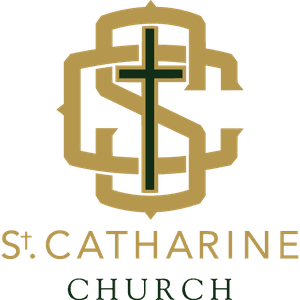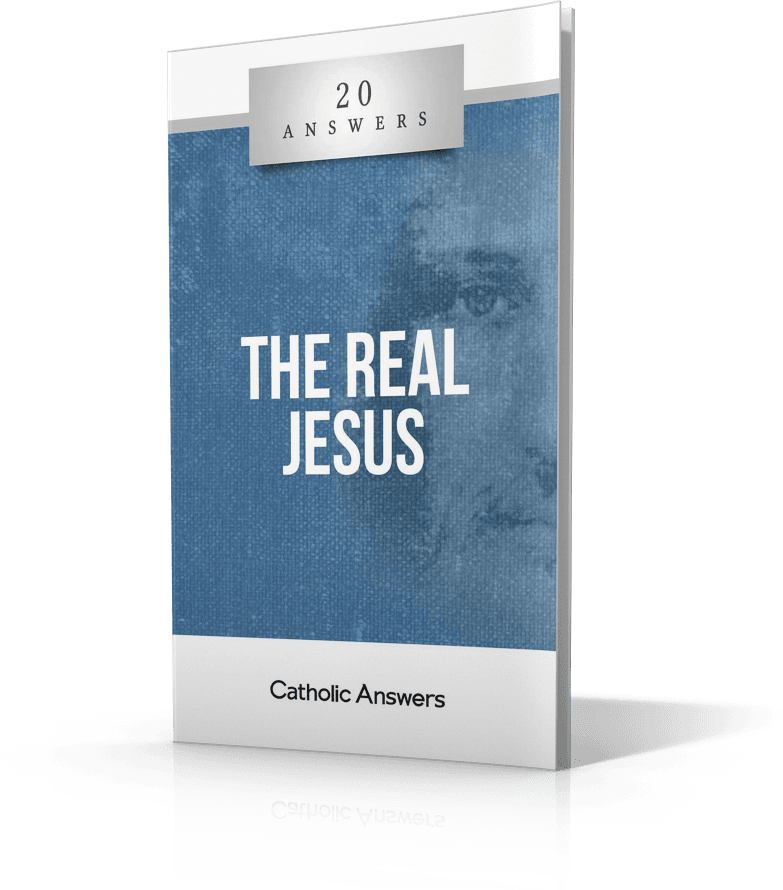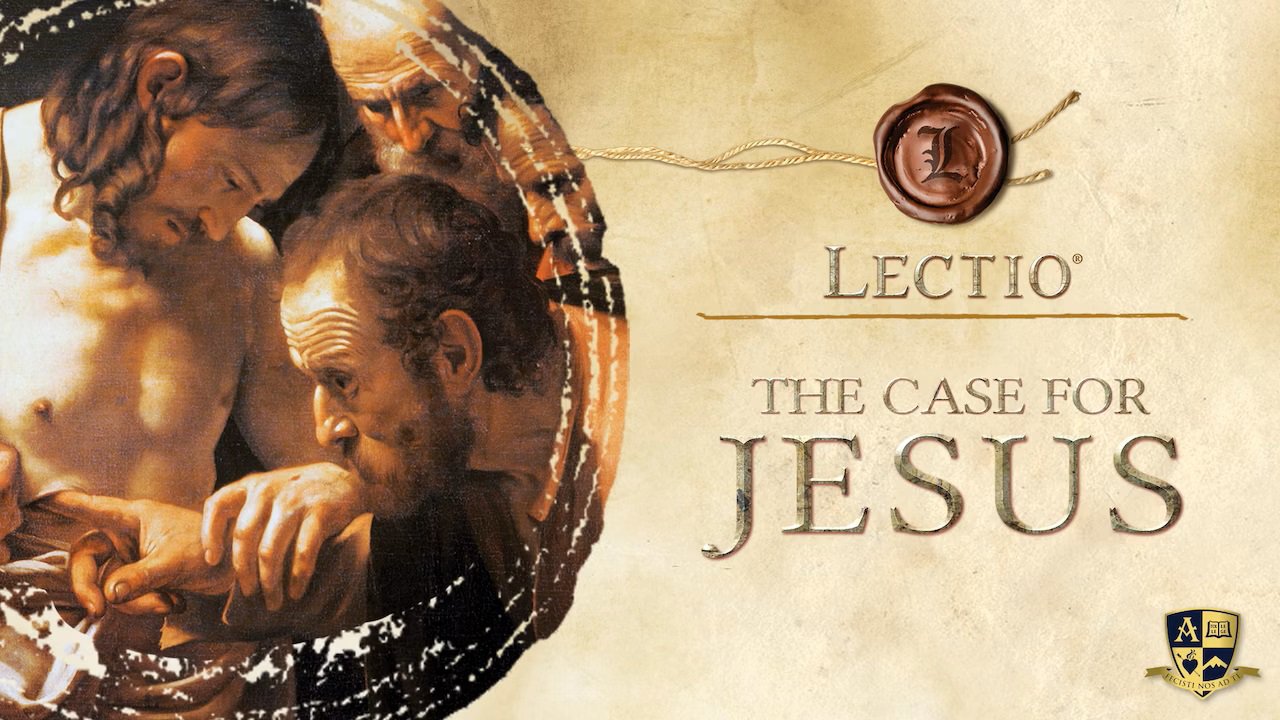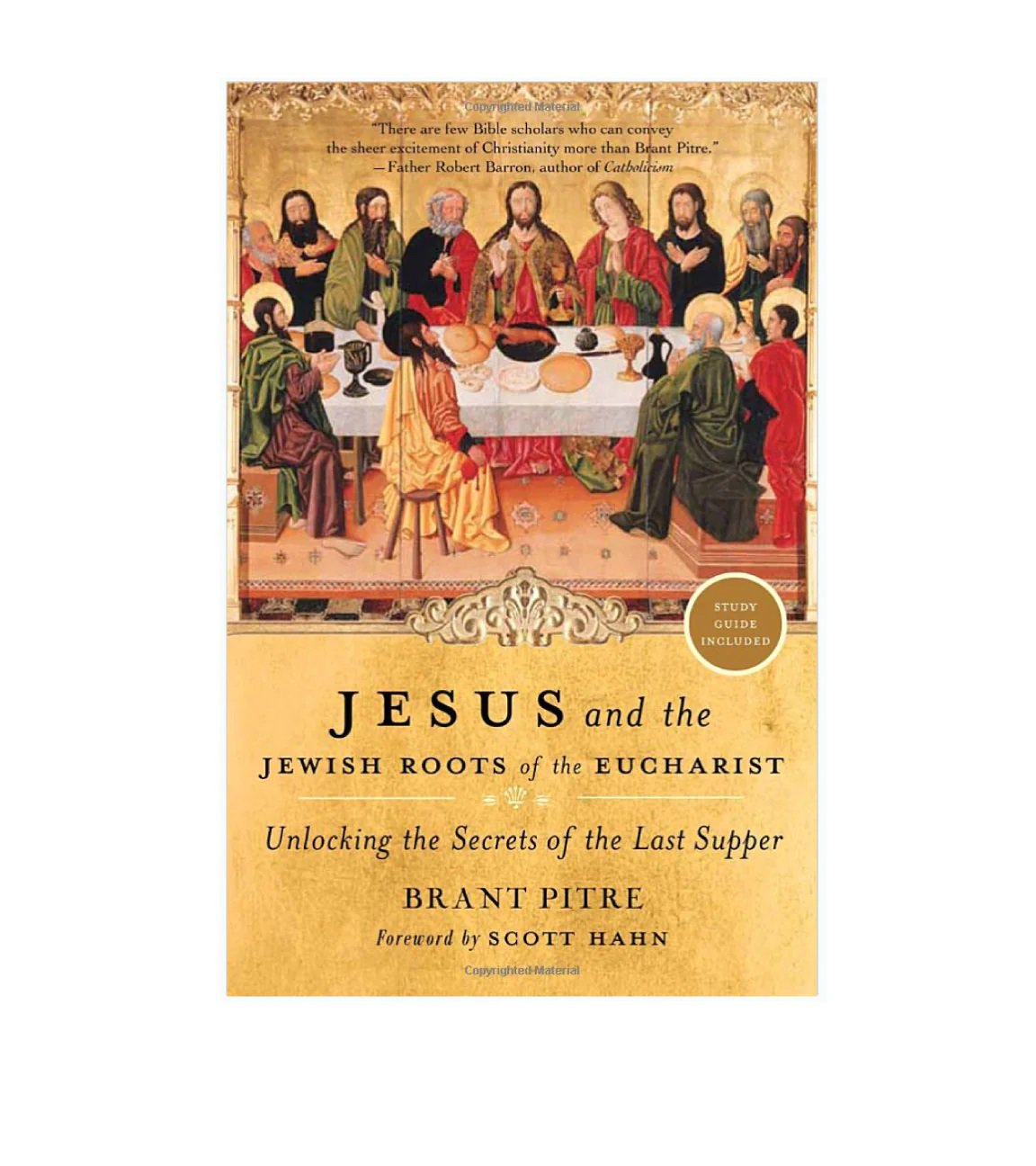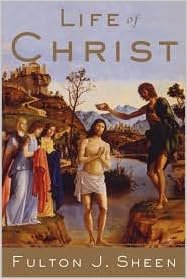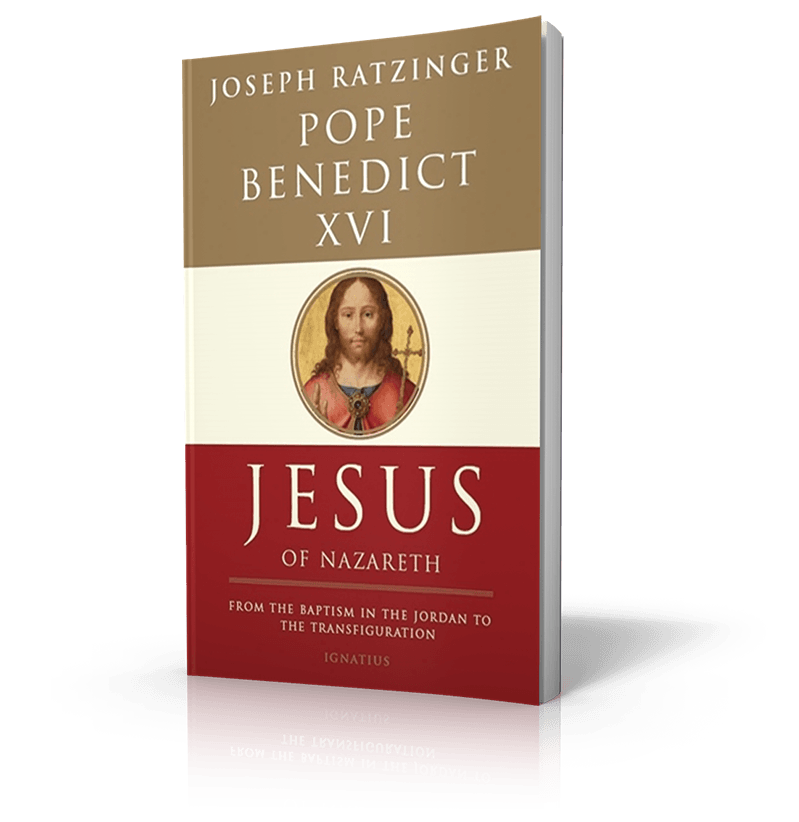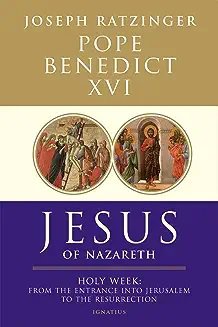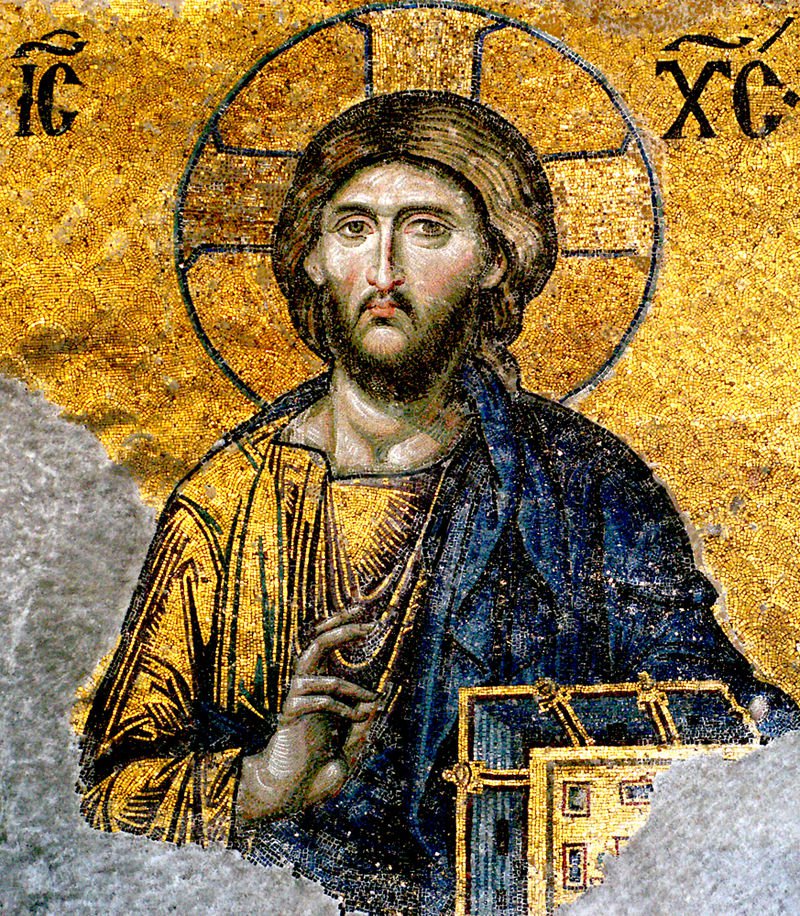
Who is Jesus?
What Good Catholics Should Do to Find the Right Answers...
First thing one should do is not assume you know all you need to know about Jesus. Many wrong turns, tragic mistakes, horrible sins and terrible tragedies have happened because someone did not know Jesus, or thought they knew Jesus.
The Wonders of the Mass and the Eucharist: Insights of the Saints
The first book on Jesus I'd like to recommend was fresh off the press this past July and comes to us from our September 29th speaker, Sr. Mary Ann Fatula.
As Sr. Mary Ann breaks opens the treasure house of writings on the Holy Eucharist, the saints will lovingly teach you about the immeasurable graces the Lord gives you at Mass and through this most wondrous sacrament. You will learn how to grow in recollection during Mass, how to cherish the Lord’s intimate presence in Holy Communion, and how to rest in the Lord in Eucharistic adoration. As your love for the Lord in the Blessed Sacrament deepens, you will begin to treasure anew the delight of the Trinity’s intimate love, the light and warmth of the Holy Spirit’s anointing, and the joyful hope of eternal salvation.
This book is available at the link below.
Footprints of God - Jesus: the Word Became Flesh
There is also great material on Formed. The first one I'd Recommend is from Steven Ray's "Footprints of God" series titled - "Jesus: the Word Became Flesh" (see picture link below). On location is Israel, Steven takes you through the life of Jesus, with insightful explanations of the key moments in the Gospels. This is a simple, beautiful and interesting presentation for Catholics.
The Real Jesus
A great booklet titled, "The Real Jesus" is from Catholic Answers. It has 20 questions and answers about Jesus, for example...
- Did Jesus even exist?
- How can we trust what the Bible says about him?
- Didn’t Jesus’s followers invent a lot of myths about him based on stories of pagan gods?
- Did the Catholic Church suppress biblical books that depicted Jesus as a simple wise man who was married and didn’t die on a cross or rise from the dead?
In this booklet you’ll find smart, solid answers to these questions and many more. The Real Jesus takes on the claims of modern skeptics about Jesus’s life, his teaching, and his legacy, providing compelling evidence that the “historical Jesus” and the “Christ of faith” are one and the same. This book in available for a $2.00 donation at the north and south vestibules of the church, or at the link below!
The Case for Jesus
If you want to go deeper into answering modern skeptics (who try and cast doubt on who Jesus is) Dr. Brant Pitre has an excellent book and video presentation titled, "The Case for Jesus".
The 9 part Lectio video series, "The Case for Jesus" on Formed is for beginners and is very well presented. However, the book is only 200 pages and makes for an easy and informative read. Both links are below. This book in available for a $5.00 donation at the north and south vestibules of the church as well.
Jesus and the Jewish Roots of the Eucharist
Also from Dr. Brant Pitre, "Jesus and the Jewish Roots of the Eucharist" is an amazing exploration of how the Eucharist was foreshadowed in the Old Testament and fulfilled in the New Testament. The following is taken form the author's introduction
By focusing on the Jewish context of Jesus' teachings, all of his words not only begin to make sense; they come alive in a way that is exciting and powerful. I can testify to this from experience; the more I've studied Jesus' teachings in their Jewish environment, the more he fascinates me, and the more he challenges me to change the way I see who he was, what he was doing, and what it means for my life today.
So, whether you're Catholic or Protestant, Jewish or Gentile, believer or nonbeliever, if you've ever wondered, Who was Jesus really? I invite you to come along with me on this journey
As we will see, it is precisely the Jewish roots of Jesus' words that will enable us to unlock the secrets of who he was and what he meant when he said to his disciples, " Take, eat, this is my body.
This book in available for a $5.00 donation at the north and south vestibules of the church, or at the link below!
To Know Christ Jesus
One of the best Catholic authors of the 20th Century, Frank Sheed, wrote a book about Jesus I can't recommend enough. To Know Christ Jesus is a masterful account of the life of Christ.
This new edition has over 100 illustrations from the French artist James Tissot’s outstanding series on the Life of Christ, which have been carefully selected and chronologically placed throughout the book. Tissot’s dynamic realism, combined with Sheed’s lucid prose, make this one of the most beautifully illustrated and profoundly moving life of Our Lord ever published.
Sheed takes us through the life of Jesus using all four Gospels. His insights are brilliant and expertly explained. If you are looking for a great book on Jesus to dive into - this is the one! The link is below!
Life of Christ
A timeless classic and just an amazing read, particularly in prayer, is "The Life of Christ" by Bishop Fulton Sheed. A master teacher, his wisdom just drips off the pages. You can't go wrong with this book! Find the link below!
Jesus of Nazareth
Last, but not least, from the man who many consider the greatest theologian to ever sit on the Chair of Peter, is the 3 book series, "Jesus of Nazareth" by Pope Benedict XVI. The first volume is on the life of Jesus during His public ministry right up to Palm Sunday. The Pope's second volume is on Jesus during Holy Week and the third is about the Nativity. See the links below.
What Every Catholic Should Know

Have you come to the point, like many Catholics do, where you realize you need to know more about your Catholic Faith?
Not that you need to be a theologian, but at least knowledgeable enough to be a good disciple of Jesus Christ. The truth of this is that you never should really stop learning how to be a better and better disciple. But this first step, acknowledging that, "I need to know more" begs the question, "Where do I start?
There are many ways to learn more about the Catholic Faith. Books, podcasts, videos, Catholic radio... and the list goes on. But if you are looking for a place to begin I would suggest the "United States Catholic Catechism for Adults". This 36 chapter book was created by the bishops of the United States to provide a simple way to systematically study the Catholic Faith based on the Catechism of the Catholic Church. You can purchase this book on Amazon, your local Catholic bookstore, or read it online. If you read 3 chapters a month you would get through the entire catechism in one year.
Although it's easy to read, there are excellent guides for this catechism. On Formed (follow this link on how to sign up for this free service) there are video introductions and printable study guides for each chapter called "Echo". This is beautiful done by Bishop Donald Hying of Madison, Wisconsin. Our Sunday Visitor has a Study Guide for the United States Catholic Catechism as well as a Reader's Journal you may find helpful.
Please contact Mike Denz via the link above with any questions you have!
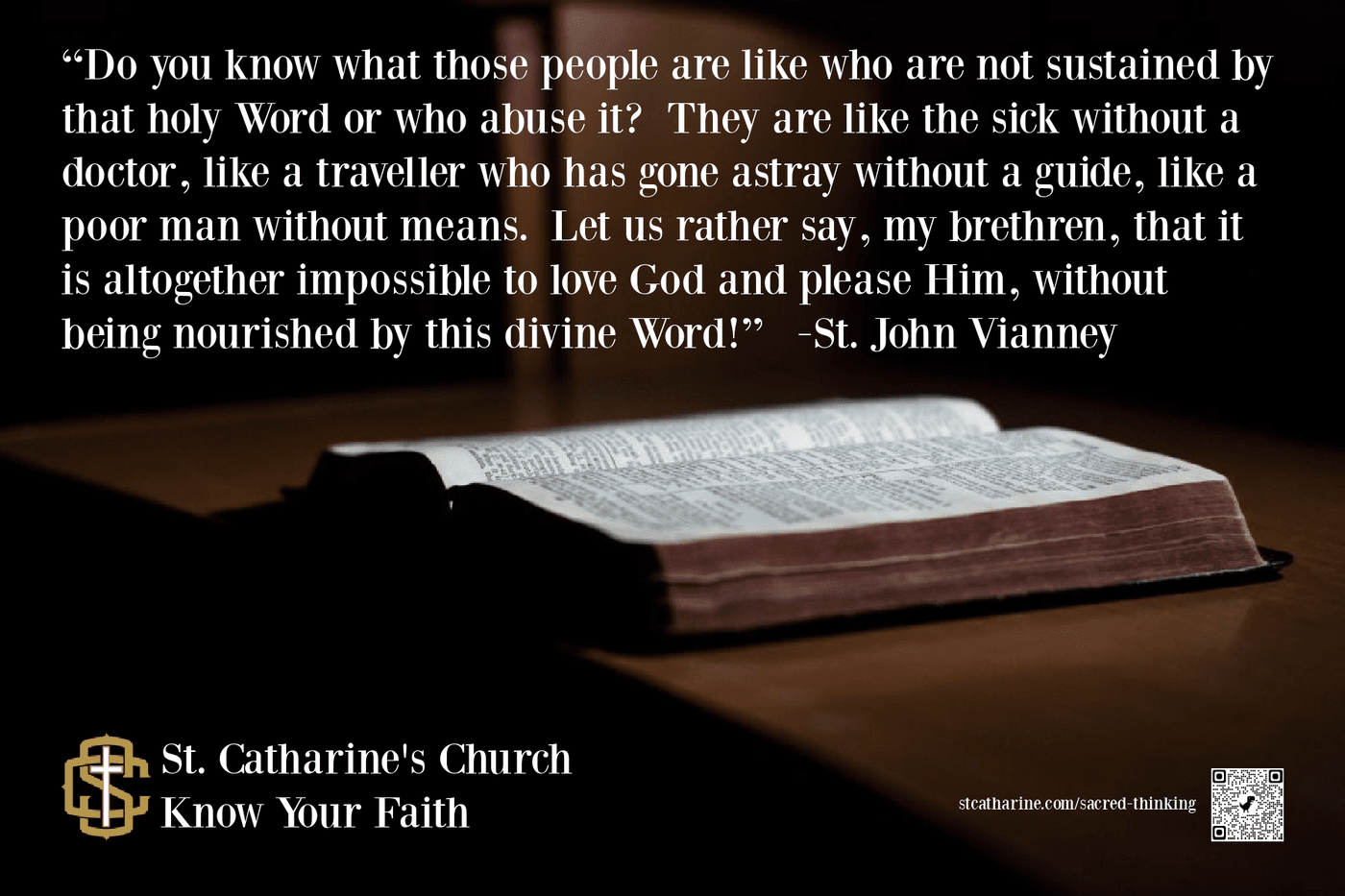
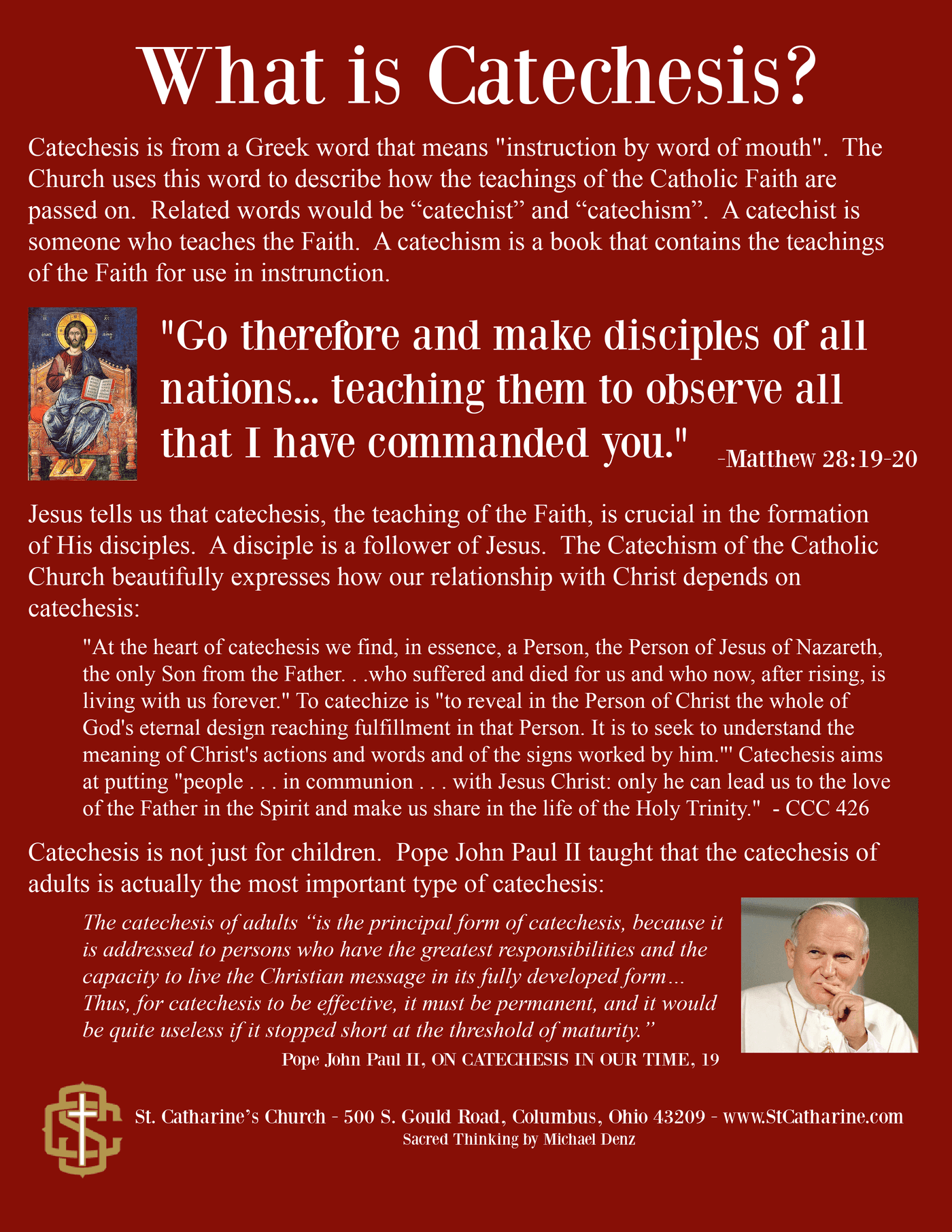
The St. Benedict Medal

By Msgr. Stephen Rossetti
Exorcist Diary #249
www.catholicexorcism.org
One of our afflicted persons was having problems communicating on her phone. So, we suggested she put a sticker with an image of the Medal of St. Benedict and attach it to her phone. She said she put the sticker on the phone and when she tried to pick up the phone, it burned. She could hardly hold it. Similarly, during one of our exorcism sessions a few weeks ago, a crucifix on the wall loudly snapped and the Benedictine medal on it flew off the wall and crashed on the ground.
It is very clear that the demons hate this medal. Practitioners of magic invoke talismans and magic formulas. We do neither of these. The power of the medal does not come from an inherent power in the medal itself. Rather, it invokes the authority of the Church and the intercession of St. Benedict, who is the patron of exorcisms. It includes ancient exorcistic prayers of the Church.
The Benedictine medal is the only sacramental I am aware of that actually includes an exorcism on it. And very clearly, it has a powerful effect on the demonic. Many of us in this ministry puts stickers with the symbol of the Benedictine medal on our phones and computers. When using our electronic devices, we have had more than a little demonic harassment. Also, we often use a crucifix with a Benedictine medal on it during our exorcisms. We encourage our laity to use these medals as well.
St. Benedict, patron of exorcisms, pray for us!
More about the St. Benedict Medal
We do not know just when the first medal of St. Benedict was struck. At some point in history a series of capital letters was placed around the large figure of the cross on the reverse side of the medal. For a long time the meaning of these letters was unknown, but in 1647 a manuscript dating back to 1415 was found at the Abbey of Metten in Bavaria, giving an explanation of the letters. They are the initial letters of a Latin prayer of exorcism against Satan, as will be explained below.
The Jubilee Medal of Montecassino
The above features were finally incorporated in a newly designed medal struck in 1880 under the supervision of the monks of Montecassino, Italy, to mark the 1400th anniversary of the birth of St. Benedict. The design of this medal was produced at Saint Martin’s Archabbey, Beuron, Germany, at the request of the prior of Montecassino, Very Rev. Boniface Krug OSB (1838-1909). Prior Boniface was a native of Baltimore and originally a monk of St. Vincent Archabbey, Latrobe, Pennsylvania, until he was chosen to become prior and latter archabbot of Montecassino.
Since that time, the Jubilee Medal of 1880 has proven to be more popular throughout the Christian world than any other medal ever struck to honor Saint Benedict.
Symbolism of Medal
Because the Jubilee Medal of 1880 has all the important features ever associated with the Medal of St. Benedict, the following description of this medal can serve to make clear the nature and intent of any medal of St. Benedict, no matter what shape or design it may legitimately have.
On the face of the medal is the image of Saint Benedict. In his right hand he holds the cross, the Christian’s symbol of salvation. The cross reminds us of the zealous work of evangelizing and civilizing England and Europe carried out mainly by the Benedictine monks and nuns, especially for the sixth to the ninth/tenth centuries.
Rule and Raven
In St. Benedict’s left hand is his Rule for Monasteries that could well be summed up in the words of the Prolog exhorting us to “walk in God’s ways, with the Gospel as our guide.”
On a pedestal to the right of St. Benedict is the poisoned cup, shattered when he made the sign of the cross over it. On a pedestal to the left is a raven about to carry away a loaf of poisoned bread that a jealous enemy had sent to St. Benedict.
C. S. P. B.
Above the cup and the raven are the Latin words: Crux s. patris Benedicti (The Cross of our holy father Benedict). On the margin of the medal, encircling the figure of Benedict, are the Latin words: Eius in obitu nostro praesentia muniamur! (May we be strengthened by his presence in the hour of our death!). Benedictines have always regarded St. Benedict as a special patron of a happy death. He himself died in the chapel at Montecassino while standing with his arms raised up to heaven, supported by the brothers of the monastery, shortly after St. Benedict had received Holy Communion.
Monte Cassino
Below Benedict we read: ex SM Casino MDCCCLXXX (from holy Monte Cassino, 1880). This is the medal struck to commemorate the 1400th anniversary of the birth of Saint Benedict.
On the Back of the medal, the cross is dominant. On the arms of the cross are the initial letters of a rhythmic Latin prayer: Crux sacra sit mihi lux!
Nunquam draco sit mihi dux! (May the holy cross be my light! May the dragon never be my guide!).
In the angles of the cross, the letters C S P B stand for Crux Sancti Patris Benedicti (The cross of our holy father Benedict).
Peace
Above the cross is the word pax (peace), that has been a Benedictine motto for centuries. Around the margin of the back of the medal, the letters V R S N S M V – S M Q L I V B are the initial letters, as mentioned above, of a Latin prayer of exorcism against Satan: Vade retro Satana! Nunquam suade mihi vana! Sunt mala quae libas. Ipse venena bibas! (Begone Satan! Never tempt me with your vanities! What you offer me is evil. Drink the poison yourself!)
Use of the Saint Benedict Medal
There is no special way prescribed for carrying or wearing the Medal of Saint Benedict. It can be worn on a chain around the neck, attached to one’s rosary, kept in one’s pocket or purse, or placed in one’s car or home.
The medal is often put into the foundations of houses and building, on the walls of barns and sheds, or in one’s place of business.
The purpose of using the medal in any of the above ways is to call down God’s blessing and protection upon us, wherever we are, and upon our homes and possessions, especially through the intercession of Saint Benedict.
By the conscious and devout use of the medal, it becomes, as it were, a constant silent prayer and reminder to us of our dignity as followers of Christ.
The medal is a prayer of exorcism against Satan, a prayer for strength in time of temptation, a prayer for peace among ourselves and among the nations of the world, a prayer that the Cross of Christ be our light and guide, a prayer of firm rejection of all that is evil, a prayer of petition that we may with Christian courage “walk in God’s ways, with the Gospel as our guide,” as Saint Benedict urges us.
A profitable spiritual experience can be ours if we but take the time to study the array of inscriptions and representations found on the two sides of the medal.
The lessons found there can be pondered over and over to bring true peace of mind and heart into our lives as we struggle to overcome the weaknesses of our human nature and realize that our human condition is not perfect, but that with the help of God and the intercession of the saints our condition can become better.
The Medal of Saint Benedict can serve as a constant reminder of the need for us to take up our cross daily and “follow the true King, Christ our Lord,” and thus learn “to share in his heavenly kingdom,” as Saint Benedict urges us in the Prolog of his Rule.
Note: I often carry with me St. Benedict medals that were blessed by Pope Francis. Whenever you see me around, just ask me and I'll be happy to give you one! -Mike Denz
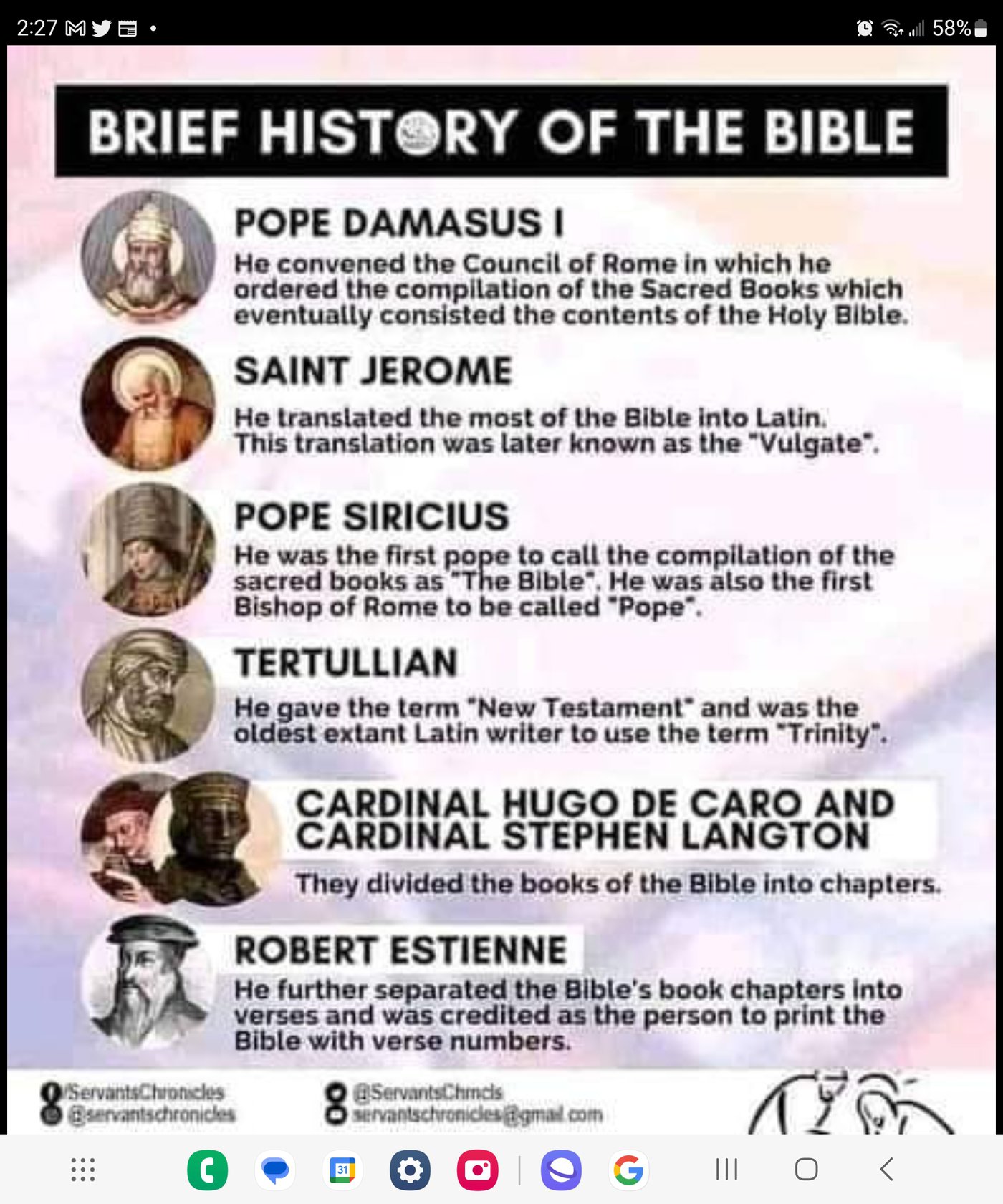
How do Saint's Feast Days and other Holy Days Work on the Church Calendar?
Solemnities, Feasts, Memorials
Answered by Legionary of Christ Father Edward McNamara, professor of liturgy at the Regina Apostolorum University.
EWTN.com
Q: We as Catholics commonly use the word "feast" to cover everything from church feasts of various saints and the Blessed Mother, to Corpus Christi, etc. We also understand that there are three kinds of feasts/celebrations: memorial, feast, solemnity. Could you kindly elaborate on these three categories?
A: Effectively we use the word "feast" to cover all levels of celebration, even though the word also has a precise technical meaning in the hierarchy of celebrations. There is no great difficulty in this, as the context usually clarifies whether we are speaking technically or in general.
The three basic classes are those mentioned by our reader, although memorials are often divided up into obligatory and optional. There are some other means of classifying the celebrations which give different numbers and categories. For example, if one classifies on the basis of which Masses may be celebrated on a given day, one comes up with seven groupings of celebrations.
The difference between the three basic categories resides in their importance, which in turn is reflected in the presence or absence of different liturgical elements.
Solemnities are the highest degree and are usually reserved for the most important mysteries of faith. These include Easter, Pentecost and the Immaculate Conception; the principal titles of Our Lord, such as King and Sacred Heart; and celebrations that honor some saints of particular importance in salvation history, such as Sts. Peter and Paul, and St. John the Baptist on his day of birth.
Solemnities have the same basic elements as a Sunday: three readings, prayer of the faithful, the Creed and the Gloria which is recited even when the solemnity occurs during Advent or Lent. It also has proper prayer formulas exclusive to the day: entrance antiphon, opening prayer, prayer over the gifts, Communion antiphon, and prayer after Communion. In most cases it also has a particular preface.
Some solemnities are also holy days of obligation, but these vary from country to country.
A solemnity is celebrated if it falls on a Sunday of ordinary time or Christmastide. But it is usually transferred to the following Monday if it falls on a Sunday of Advent, Lent or Easter, or during Holy Week or the Easter octave.
A feast honors a mystery or title of the Lord, of Our Lady, or of saints of particular importance (such as the apostles and Evangelists) and some of historical importance such as the deacon St. Lawrence.
The feast usually has some proper prayers but has only two readings plus the Gloria. Feasts of the Lord, such as the Transfiguration and Exaltation of the Holy Cross, unlike other feasts, are celebrated when they fall on a Sunday. On such occasions they have three readings, the Gloria and the Creed.
A memorial is usually of saints but may also celebrate some aspect of the Lord or of Mary. Examples include the optional memorial of the Holy Name of Jesus or the obligatory memorial of the Immaculate Heart of Mary.
From the point of view of the liturgical elements there is no difference between the optional and obligatory memorial. The memorial has at least a proper opening prayer and may have proper readings suitable for the saint being celebrated. The readings of the day may be used, and the lectionary recommends against an excessive use of specific readings for the saints so as not to interrupt too much the continuous cycle of daily readings.
On the other hand, the specific readings should always be used for certain saints, above all those specifically mentioned in the readings themselves, such as Martha, Mary Magdalene and Barnabas.
During Lent and Advent from Dec. 17 to 24 memorials may be celebrated only as commemorations. That is, only the opening prayer of the saint is used and all the rest comes from the day.
Nov. 2, All Souls' Day, is something of a special class that, without being a solemnity, still has precedence over a Sunday.
It is also important to note that the same celebration may have a different classification in various geographical areas, as some celebrations and saints are venerated more in one place than in another. For example, St. Benedict, an obligatory memorial in the universal calendar, is a feast in Europe since he is one of its patrons. But he rates a solemnity in the diocese and abbey of Montecassino where he is buried.
Finally, the decision on whether a solemnity such as the Body and Blood of the Lord is a holy day of obligation falls primarily upon the bishops' conference, which decides based on the pastoral reality of each country. Some have maintained the traditional Thursday celebration and kept it as a holy day; others might have maintained the day but without the obligation. Many have preferred to transfer the celebration to the following Sunday so as to ensure its celebration with the greatest number of faithful.
The Vatican, for example, continues the traditional Thursday celebration and thus the Holy Father's procession with the Blessed Sacrament is held on that day. The Diocese of Rome, however, along with the rest of Italy, celebrates it on the following Sunday.
Church Calendar of Solemnities, Feasts and Memorials
Key:
BOLD AND ALL CAPS is a Solemnity.
Bold with Regular type is a Feast
Regular type is a Memorial
Regular type Italic is an Optional Memorial.
The Movable Feasts
The feasts of Holy Family, Epiphany and Baptism of the Lord are determined according to the day of the week when Christmas falls. All the other feasts are dependent on Easter. Once Easter is determined, all the others line up with the date of Easter.
- Feast of the Holy Family
- EPIPHANY (for some countries like the United States)
- Baptism of the Lord
- Ash Wednesday
- PASSION SUNDAY
- HOLY THURSDAY
- GOOD FRIDAY
- EASTER
- OCTAVE OF EASTER/DIVINE MERCY SUNDAY
- ASCENSION
- PENTECOST
- MOST HOLY TRINITY
- Memorial of BVM, Mother of the Church
- CORPUS CHRISTI
- SACRED HEART
- Memorial of the Immaculate Virgin Mary
- CHRIST THE KING
Feasts According to Months
Except for times when a Sunday or higher ranked "movable feast" either moves or cancels one of the feasts listed below, these are the dates on which they would be celebrated.
January
- 1: Octave Day of Christmas, MARY, MOTHER OF GOD – Solemnity
- 2: Basil the Great and Gregory Nazianzen, bishops and doctors – Memorial
- 3: The Most Holy Name of Jesus – Optional Memorial
- 4: Elizabeth Ann Seton – Memorial (United States)
- 5: John Neumann, bishop, Memorial (United States)
- 6: EPIPHANY (for some countries where it is a Holy Day of Obligation. Other countries including U.S. celebrate on the first Sunday after 1 January) – Solemnity, or Andre Bessette, religious (United States)
- 7: Raymond of Penyafort, priest – Optional Memorial
- 13: Hilary of Poitiers, bishop and doctor – Optional Memorial
- 17: Anthony of Egypt, abbot – Memorial
- 20: Fabian, pope and martyr; or Sebastian, martyr – Optional Memorials
- 21: Agnes, virgin and martyr – Memorial
- 22: Vincent, deacon and martyr – Optional Memorial
- 23: Vincent, deacon and martyr; Marianne Cope, virgin – Optional Memorials (United States)
- 24: Francis de Sales, bishop and doctor – Memorial
- 25: The Conversion of Paul, apostle – Feast
- 26: Timothy and Titus, bishops – Memorial
- 27: Angela Merici, virgin – Optional Memorial
- 28: Thomas Aquinas, priest and doctor – Memorial
- 31: John Bosco, priest – Memorial
February
- 2: Presentation of the Lord – Feast
- 3: Blase, bishop and martyr, or Ansgar, bishop – Optional Memorials
- 4: Agatha, virgin and martyr – Memorial
- 6: Paul Miki and companions, martyrs – Memorial
- 8: Jerome Emiliani, priest, or Josephine Bakhita, virgin – Optional Memorials
- 10: Scholastica, virgin – Memorial
- 11: Our Lady of Lourdes – Optional Memorial
- 14: Cyril, monk, and Methodius, bishop – Memorial
- 17: Seven Holy Founders of the Servite Order – Optional Memorial
- 21: Peter Damian, bishop and doctor of the Church – Optional Memorial
- 22: Chair of Peter, apostle – Feast
- 23: Polycarp, bishop and martyr – Memorial
March
- 3: Katharine Drexel, virgin – Optional Memorial (United States)
- 4: Casimir – Optional Memorial
- 7: Perpetua and Felicity, martyrs – Memorial
- 8: John of God, religious – Optional Memorial
- 9: Frances of Rome, religious – Optional Memorial
- 17: Patrick, bishop – Optional Memorial
- 18: Cyril of Jerusalem, bishop and doctor – Optional Memorial
- 19: JOSEPH HUSBAND OF THE BLESSED VIRGIN MARY – Solemnity
- 23: Turibius of Mogrovejo, bishop – Optional Memorial
- 25: ANNUNCIATION OF THE LORD – Solemnity
April
- 2: Francis of Paola, hermit – Optional Memorial
- 4: Isidore, bishop and doctor of the Church – Optional Memorial
- 5: Vincent Ferrer, priest – Optional Memorial
- 7: John Baptist de la Salle, priest – Memorial
- 11: Stanislaus, bishop and martyr – Memorial
- 13: Martin I, pope and martyr – Optional Memorial
- 21: Anselm of Canterbury, bishop and doctor of the Church – Optional Memorial
- 23: George, martyr, or Adalbert, bishop and martyr – Optional Memorial
- 24: Fidelis of Sigmaringen, priest and martyr – Optional Memorial
- 25: Mark the Evangelist – Feast
- 28: Peter Chanel, priest and martyr; or Louis Grignon de Montfort, priest – Optional Memorials
- 29: Catherine of Siena, virgin and doctor of the Church – Memorial
- 30: Pius V, pope – Optional Memorial
May
- 1: Joseph the Worker – Optional Memorial
- 2: Athanasius, bishop and doctor – Memorial
- 3: Philip and James, Apostles – Feast
- 10: Damien de Veuster, priest – Optional Memorial (United States)
- 12: Nereus and Achilleus, martyrs or Pancras, martyr – Optional Memorial
- 13: Our Lady of Fatima – Optional Memorial
- 14: Matthias the Apostle – Feast
- 15: Isidore the Farmer – Optional Memorial (United States)
- 18: John I, pope and martyr – Optional Memorial
- 20: Bernardine of Siena, priest – Optional Memorial
- 21: Christopher Magallanes and companions, martyrs – Optional Memorial
- 22: Rita of Cascia – Optional Memorial
- 25: Bede the Venerable, priest and doctor; or Gregory VII, pope or Mary Magdalene de Pazzi, virgin – Optional Memorials
- 26: Philip Neri, priest – Memorial
- 27: Augustine (Austin) of Canterbury, bishop – Optional Memorial
- 31: Visitation of the Blessed Virgin Mary – Feast
June
- 1: Justin Martyr – Memorial
- 2: Marcellinus and Peter, martyrs – Optional Memorial
- 3: Charles Lwanga and companions, martyrs – Memorial
- 5: Boniface, bishop and martyr – Memorial
- 6: Norbert, bishop – Optional Memorial
- 9: Ephrem, deacon and doctor – Optional Memorial
- 11: Barnabas the Apostle – Memorial
- 13: Anthony of Padua, priest and doctor – Memorial
- 19: Romuald, abbot – Optional Memorial
- 21: Aloysius Gonzaga, religious – Memorial
- 22: Paulinus of Nola, bishop or John Fisher, bishop and martyr and Thomas More, martyr – Optional Memorials
- 24: BIRTH OF JOHN THE BAPTIST – Solemnity
- 27: Cyril of Alexandria, bishop and doctor – Optional Memorial
- 28: Irenaeus, bishop and martyr – Memorial
- 29: PETER AND PAUL, Apostles – Solemnity
- 30: First Martyrs of the Church of Rome – Optional Memorial
July
- 1: Junípero Serra, priest – Optional Memorial (United States)
- 3: Thomas the Apostle – Feast
- 5: Anthony Zaccaria, priest – Optional Memorial or Elizabeth of Portugal – Optional Memorial (United States)
- 6: Maria Goretti, virgin and martyr – Optional Memorial
- 9: Augustine Zhao Rong and companions, martyrs – Optional Memorial
- 11: Benedict, abbot – Memorial
- 13: Henry – Optional Memorial
- 14: Camillus de Lellis, priest – Optional Memorial or Kateri Tekakwitha, virgin – Memorial (United States)
- 15: Bonaventure, bishop and doctor – Memorial
- 16: Our Lady of Mount Carmel – Optional Memorial
- 18: Camillus de Lellis, priest – Optional Memorial (United States)
- 20: Apollinaris, bishop and martyr – Optional Memorial
- 21: Lawrence of Brindisi, priest and doctor – Optional Memorial
- 22: Mary Magdalene – Feast
- 23: Birgitta, religious – Optional Memorial
- 24: Sharbel Makhluf, hermit – Optional Memorial
- 25: James, apostle – Feast
- 26: Joachim and Anne – Memorial
- 29: Martha – Memorial
- 30: Peter Chrysologus, bishop and doctor – Optional Memorial
- 31: Ignatius of Loyola, priest – Memorial
August
- 1: Alphonsus Maria de Liguori, bishop and doctor of the Church – Memorial
- 2: Eusebius of Vercelli, bishop, or Peter Julian Eymard, priest – Optional Memorials
- 4: Jean Vianney (the Curé of Ars), priest – Memorial
- 5: Dedication of the Basilica of Mary Major – Optional Memorial
- 6: Transfiguration of the Lord – Feast
- 7: Sixtus II, pope, and companions, martyrs, or Cajetan, priest – Optional Memorial
- 8: Dominic, priest – Memorial
- 9: Teresa Benedicta of the Cross (Edith Stein), virgin and martyr – Optional Memorial
- 10: Lawrence, deacon and martyr – Feast
- 11: Clare, virgin – Memorial
- 12: Jane Frances de Chantal, religious – Optional Memorial
- 13: Pontian, pope, and Hippolytus, priest, martyrs – Optional Memorialli>
- 14: Maximilian Mary Kolbe, priest and martyr – Memorial
- 15: ASSUMPTION OF THE BLESSED VIRGIN MARY– Solemnity
- 16: Stephen of Hungary – Optional Memorial
- 19: John Eudes, priest – Optional Memorial
- 20: Bernard of Clairvaux, abbot and doctor of the Church – Memorial
- 21: Pius X, pope – Memorial
- 22: Queenship of Blessed Virgin Mary – Memorial
- 23: Rose of Lima, virgin – Optional Memorial
- 24: Bartholomew the Apostle – Feast
- 25: Louis or Joseph of Calasanz, priest – Optional Memorial
- 27: Monica – Memorial
- 28: Augustine of Hippo, bishop and doctor of the Church – Memorial
- 29: The Beheading of John the Baptist, martyr – Memorial
September
- 3: Gregory the Great, pope and doctor – Memorial
- 8: Birth of the Blessed Virgin Mary – Feast
- 9: Peter Claver, priest – Optional Memorial (Memorial in United States)
- 12: Holy Name of the Blessed Virgin Mary – Optional Memorial
- 13: John Chrysostom, bishop and doctor – Memorial
- 14: Exaltation of the Holy Cross – Feast
- 15: Our Lady of Sorrows – Memorial
- 16: Cornelius, pope, and Cyprian, bishop, martyrs – Memorial
- 17: Robert Bellarmine, bishop and doctor – Optional Memorial
- 19: Januarius, bishop and martyr – Optional Memorial
- 20: Andrew Kim Taegon, priest, and Paul Chong Hasang and companions, martyrs – Memorial
- 21: Matthew the Evangelist, Apostle, Evangelist – Feast
- 23: Pio of Pietrelcina (Padre Pio), priest – Memorial
- 26: Cosmas and Damian, martyrs – Optional Memorial
- 27: Vincent de Paul, priest – Memorial
- 28: Wenceslaus, martyr or Lawrence Ruiz and companions, martyrs – Optional Memorial
- 29: Michael, Gabriel and Raphael, Archangels – Feast
- 30: Jerome, priest and doctor – Memorial
October
- 1: Thérèse of the Child Jesus, virgin and doctor – Memorial
- 2: Guardian Angels – Memorial
- 3: Francis of Assisi – Memorial
- 5: Blessed Francis Xavier Seelos, priest – Optional Memorial (United States)
- 6: Bruno, priest – Optional Memorial; Blessed Marie-Rose Durocher, virgin – Optional Memorial (United States)
- 7: Our Lady of the Rosary – Memorial
- 9: Denis and companions, martyrs or John Leonardi, priest – Optional Memorial
- 11: John XXIII, pope – Optional Memorial
- 14: Callistus I, pope and martyr – Optional Memorial
- 15: Teresa of Jesus, virgin and doctor – Memorial
- 16: Hedwig, religious or Margaret Mary Alacoque, virgin – Optional Memorial
- 17: Ignatius of Antioch, bishop and martyr – Memorial
- 18: Luke the Evangelist – Feast
- 19: Jean de Brébeuf, Isaac Jogues, priests and martyrs; and their companions, martyrs or Paul of the Cross, priest – Optional Memorial; (United States Jean de Brébeuf et al is a Memorial, and Paul of the Cross moved to Oct 20)
- 20: (Paul of the Cross, priest – Optional Memorial, United States)
- 22: John Paul II, pope – Optional Memorial
- 23: John of Capistrano, priest – Optional Memorial
- 24: Anthony Mary Claret, bishop – Optional Memorial
- 28: Simon and Jude, apostles – Feast
November
- 1: ALL SAINTS – Solemnity
- 2: COMMEMORATION OF ALL SOULS – ranked with solemnities
- 3: Martin de Porres, religious – Optional Memorial
- 4 : Charles Borromeo, bishop – Memorial
- 9: Dedication of the Lateran basilica – Feast
- 10: Leo the Great, pope and doctor – Memorial
- 11: Martin of Tours, bishop – Memorial
- 12: Josaphat, bishop and martyr – Memorial
- 13: Frances Xavier Cabrini, virgin – Memorial (United States)
- 15: Albert the Great, bishop and doctor – Optional Memorial
- 16: Margaret of Scotland or Gertrude the Great, virgin – Optional Memorials
- 17: Elizabeth of Hungary, religious – Memorial
- 18: Dedication of the basilicas of Peter and Paul, Apostles – Optional Memorial; Rose Philippine Duchesne, virgin – Optional Memorial (United States)
- 21: Presentation of the Blessed Virgin Mary – Memorial
- 22: Cecilia, martyr – Memorial
- 23: Clement I, pope and martyr or Columban, religious – Optional Memorial; Blessed Miguel Agustín Pro, priest and martyr – Optional Memorial (United States)
- 24: Andrew Dung-Lac and his companions, martyrs – Memorial
- 25: Catherine of Alexandria, martyr – Optional Memorial
- 30: Andrew the Apostle – Feast
December
- 3: Francis Xavier, priest – Memorial
- 4 : John Damascene, priest and doctor – Optional Memorial
- 6: Nicholas, bishop – Optional Memorial
- 7: Ambrose, bishop and doctor – Memorial
- 8: IMMACULATE CONCEPTION OF THE BLESSED VIRGIN MARY – Solemnity
- 9: Juan Diego – Optional Memorial
- 11: Damasus I, pope – Optional Memorial
- 12: Our Lady of Guadalupe – Optional Memorial (Feast for United States)
- 13: Lucy of Syracuse, virgin and martyr – Memorial
- 14: John of the Cross, priest and doctor – Memorial
- 21: Peter Canisius, priest and doctor – Optional Memorial
- 23: John of Kanty, priest – Optional Memorial
- 25: NATIVITY OF THE LORD (CHRISTMAS) – Solemnity
- 26: Stephen, the first martyr – Feast
- 27: John the Apostle and evangelist – Feast
- 28: Holy Innocents, martyrs – Feast
- 29: Thomas Becket, bishop and martyr – Optional Memorial
- 31: Sylvester I, pope – Optional Memorial
Sacred Heart of Jesus
June is the Month of the Sacred Heart. The Solemnity of the Sacred Heart is a movable feast, always occurring on the Friday after Corpus Christi Sunday. This year it was on June 16.
For a Novena to the Sacred Heart of Jesus, click HERE.
For an amazing and most informative explanation of devotions, specifically the devotion to the Sacred Heart of Jesus, click HERE.
From St. Pio
“The longer the trial to which God subjects you, the greater the goodness in comforting you during the time of the trial and in the exaltation after the combat.”
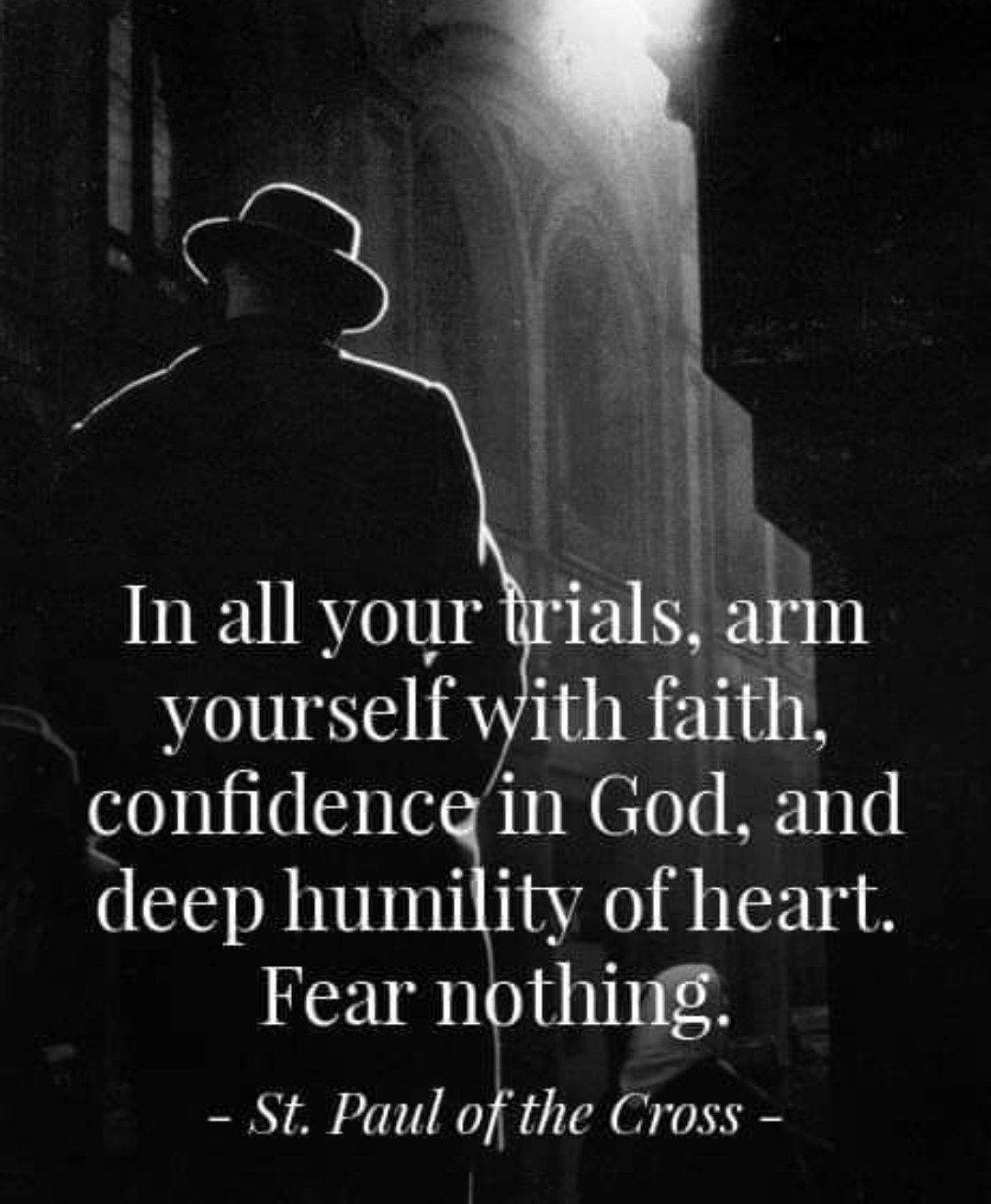
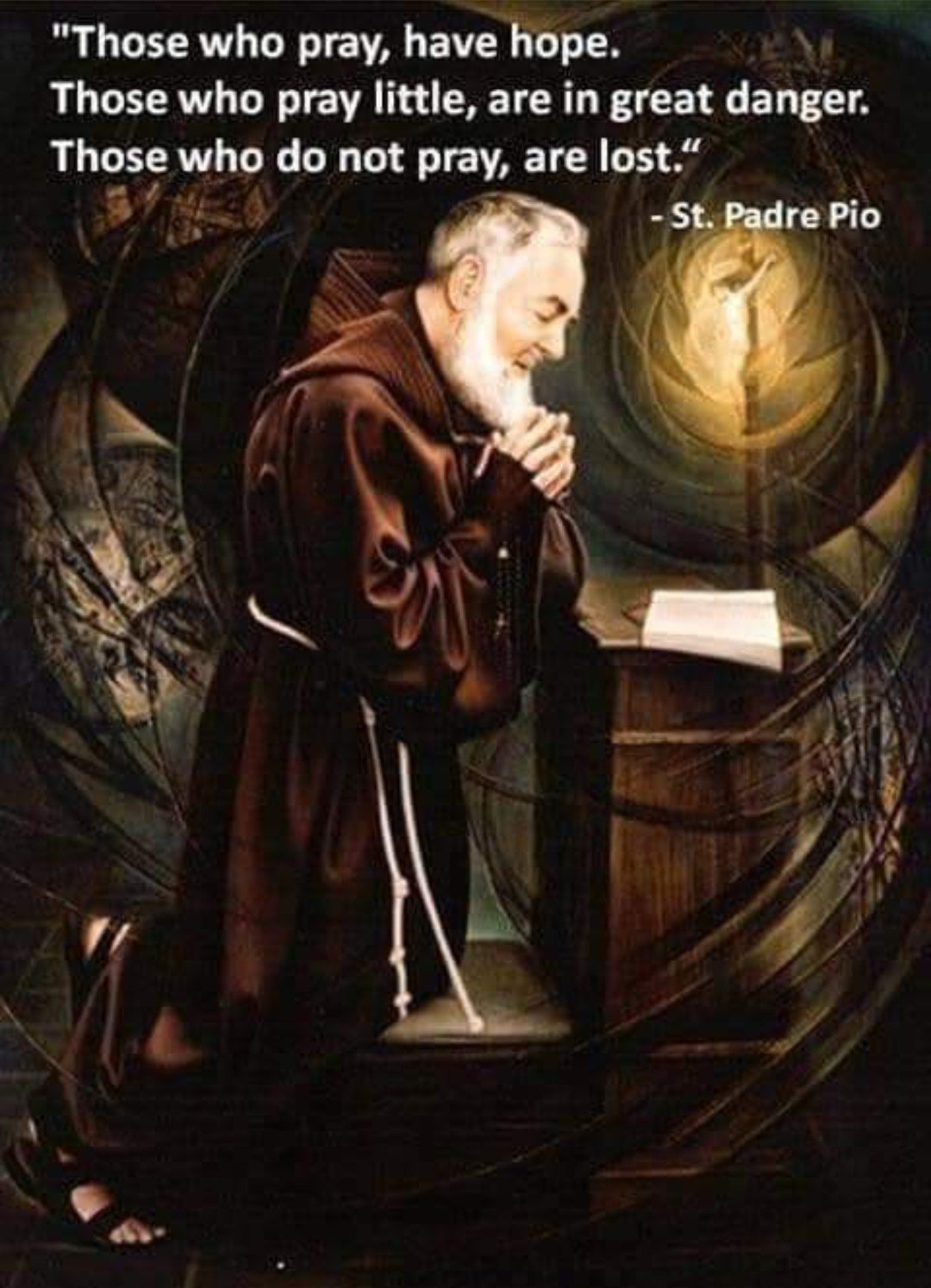

One of My All Time Favorites
As a young adult, when my serious interest in learning about our Faith began, this is the author I read. And once I started reading Frank Sheed I was hooked.
The Map of Life was written 90 years ago, but It is still the standard when it comes to a beginners book on the Catholic Faith. Frank Sheet begins with "The Problem of Life's Purpose" and then weaves together the central mysteries of our Faith, helping us understand them and showing how they inform our Life's purpose. Including "The Creation and Fall", "The Incarnation", "The Mystical Body", "The Trinity, "Law and Sin", "The Supernatural Life", and "Heaven, Purgatory, Hell" and more, Sheed expertly maps out each topic for the reader.
A hard copy can be yours for only $5.00 (just email me at Mike@stcatharine.com) or for just 99 cents you can have the electronic version from Amazon.
Either way, this short book (under 150 pages) is so easy to read, you will have not trouble understanding the basics of the Faith better that you ever thought.


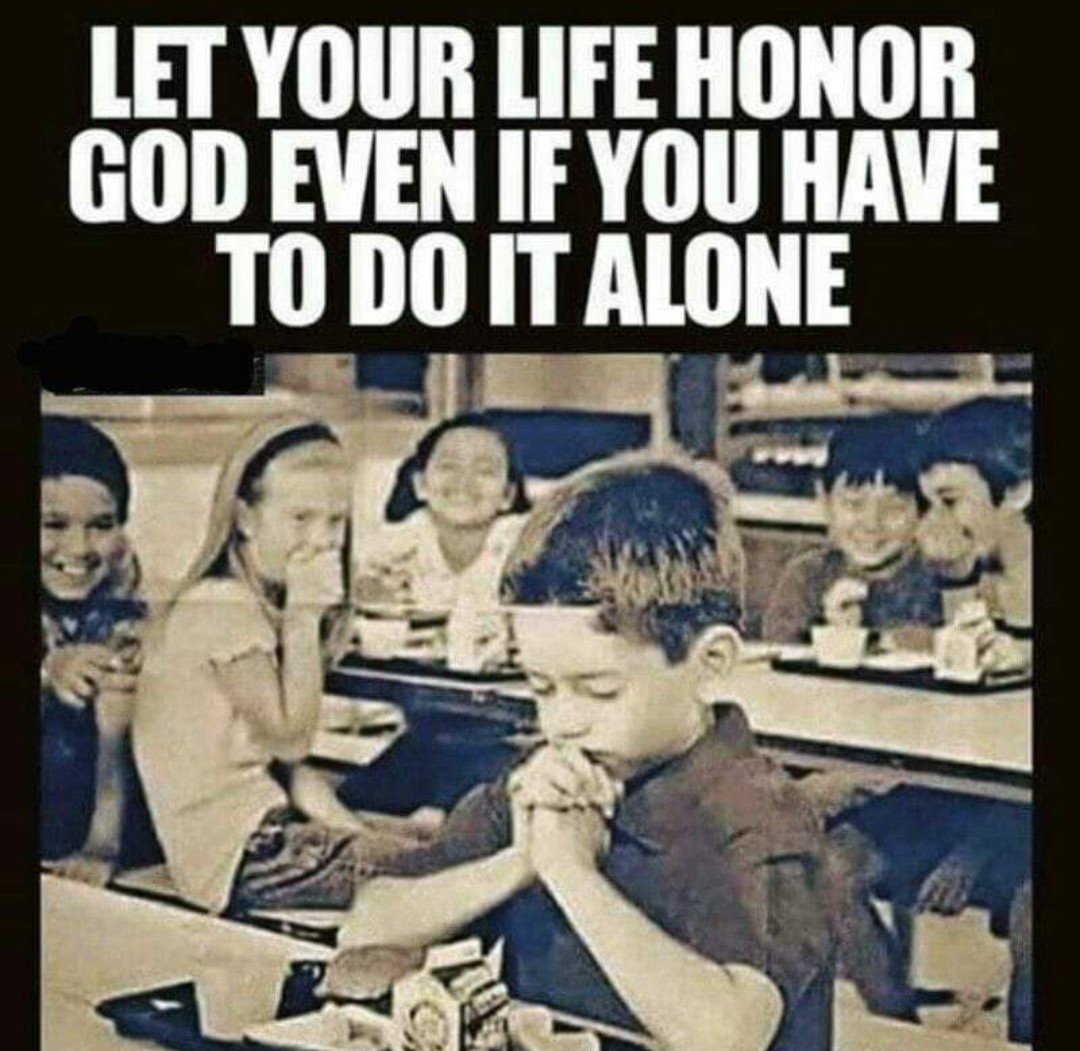

The Blood of the Lamb
We know that Jesus died to give us His Precious Blood to save us from the wounds of sin. But did you know what blood does for regular wounds? How blood heals our physical wounds points to how the Blood of Christ heals our souls. God created blood and chose to give us His blood for a reason.
According to www.hopkinsmedicine.org:
When your skin is cut, scraped, or punctured, you usually start to bleed. Within minutes or even seconds, blood cells start to clump together and clot, protecting the wound and preventing further blood loss. These clots, which turn into scabs as they dry, are created by a type of blood cell called a platelet. The clot also contains a protein called fibrin, which forms a net to hold the clot in place.
So our blood actually dies to protect the wound so it can heal. It dies for us. Sound familiar?
Once the wound is closed with a clot, the blood vessels can open a bit to allow fresh nutrients and oxygen into the wound for healing. Blood-borne oxygen is essential for healing.
So our blood brings oxygen, which is essential for healing. The oxygen comes from our breathing. Breath has always been a sign of the Holy Spirit.
“the LORD God… breathed into his nostrils the breath of life; and man became a living being.” -Genesis 2:7
Jesus said to them again, "Peace be with you. As the Father has sent me, even so I send you." And when he had said this, he breathed on them, and said to them, ‘Receive the Holy Spirit.’” -John 20:21-22
Another type of blood cell, a white blood cell called a macrophage, takes on the role of wound protector. This cell fights infection and oversees the repair process. Macrophages also produce chemical messengers, called growth factors, which help repair the wound.
Our blood protects the wound from what who would hurt us and helps repairs our wound.
“But the Lord is faithful; he will strengthen you and guard you from evil.” -2 Thessalonians 3:3
Blood cells, including oxygen-rich red blood cells, arrive to help build new tissue.
“And he who sat upon the throne said, ‘Behold, I make all things new.’” -Revelation 21:5
So, just like our own blood helps us in physical ways, the blood of Christ helps us in powerful spiritual ways, including protecting us from that evil serpent, the devil.
Speaking of serpents, do you know what animal’s blood is immune to the venom of vipers and rattle snakes?
The Blood of the Lamb.
The Sacred Heart of Jesus
The Solemnity of the Sacred Heart is Friday, June 24. For a Novena to the Sacred Heart of Jesus, click HERE. For an amazing and most informative explanation of devotions, specifically the devotion to the Sacred Heart of Jesus, click HERE.
Deep Happiness and Heavenly Destiny
Deep happiness is in the spirit, not the body or even the feelings. It is like an anchor that holds fast and calm on the bottom even while storms rage on the surface. God allows physical and emotional storms to strengthen the anchor, fires to test and harden our mettle.
Our souls must become bright, hard, sharp swords. That is our destiny and his design. We are not toys; we are swords. And that requires tempering in the fire. The sword of the self is to sing in the sun eternally, like the seraphim. If we could catch even a glimpse of this heavenly destiny, if we understood why we are destined to judge angels (1 Cor 6:3), we would not see a problem in the sufferings of Job.
Teresa of Avila said that the most miserable earthly life, seen from the perspective of heaven, looks like one night in an inconvenient hotel.
- Peter Kreeft and Fr Ronald Tacelli, Handbook of Catholic Apologetics, The Problem of Evil
Mercy
Mercy thrives in the souls of those alone who visualize everything in conspectu Dei (with the eyes of God); who, in full awakeness, measure everything by supernatural standards. It also presupposes an inward suppleness and fluidity; a thoroughly melted, quickened, liberated heart. Every inward scar, as it were – every “hardening,” every “incrustation” brought about by an experience we have failed to rectify before God – dams up the flux of mercy. Nay, the path of mercy is thwarted by every kind of inner unfreedom: by our bondage, for example, to anxiety or to disgust; to the rancor evoked in us by an insult; and in general to every over-emphatic preoccupation. For everything that stunts our freedom tends to make us self-conscious and to deprive us of the capacity, implied in mercy, of taking our stand “above the situation.” He alone who has attained the supernatural sovereignty that results from the true freedom and that is reserved for those who seek only the kingdom of God and His justice, who expects nothing of his own forces but everything of God – he alone can participate in the specifically divine virtue of mercy.
-Dietrich von Hildebrand, “Transformation in Christ”
Talks from Our Lenten Conference by Dr. David Anders
 Dr. David Anders
Dr. David AndersWe were blessed with some amazing talks by Dr. David Anders at our Lenten Conference on March 19, 2022. If you did not get a chance to attend the conference, or if you did and would like to hear them again, just click HERE and enjoy!
What is Truth?
Sacred Thinking by Mike Denz
February 28, 2022
Today people seem to have lost an understanding of objective truth.
The powers of the world around us are subtlety, and sometimes not so subtlety, nudging and pushing people to believe that everything is subjective – that there is no objective truth, or that we can make or define our own truth...that what is true depends on an individual’s thoughts and feelings on the subject.
Catholic Trivia
The Obstacle - St. Peter and the Devil
In the sixteenth chapter of the Gospel of Matthew we see two very interesting and seemingly different encounters Peter has with Jesus.
First, Jesus installs Peter as the first pope:
“But who do you say that I am?” Simon Peter replied, “You are the Christ, the Son of the living God.” And Jesus answered him, “Blessed are you, Simon Bar-Jona! For flesh and blood has not revealed this to you, but my Father who is in heaven. And I tell you, you are Peter, and on this rock I will build my church, and the powers of death shall not prevail against it. I will give you the keys of the kingdom of heaven, and whatever you bind on earth shall be bound in heaven, and whatever you loose on earth shall be loosed in heaven.”
Verses 15-19
Then, just 2 verses later, this happens…
From that time Jesus began to show his disciples that he must go to Jerusalem and suffer many things from the elders and chief priests and scribes, and be killed, and on the third day be raised. And Peter took him and began to rebuke him, saying, “God forbid, Lord! This shall never happen to you.” But he turned and said to Peter, “Get behind me, Satan! You are a hindrance to me; for you are not on the side of God, but of men.”
verses 21-23
At first one might think Jesus a little harsh, poor old Peter was just worried about Jesus. How odd it would have seemed if Peter would have responded, “That’s a great idea! How soon can we expect your suffering and death to begin?”
But, of course, Jesus was correct (Hint – He always is). This response by Our Lord states an essential fact – any suggestion that Jesus should alter His Father’s plan or disobey His Father’s will is from Satan. We also see the human nature of Jesus. He does not enjoy suffering anymore that any other human, so He does not want any distractions or temptations to His mission, which includes suffering.
Here we see how far our thoughts are from the thoughts of God. We avoid suffering to the extent that it alters our way of thinking – far from God’s way of thinking. Peter was thinking like a human – avoid suffering whenever possible. He was following the lie of this disordered human value system.
However, besides this being a rebuke of Peter for letting Satan influence him, there is another way to look at the response Our Lord gave to Peter. Specifically the first sentence, “Get behind me, Satan! You are an obstacle to me.” Look at Satan (and sin) not as an obstacle to Jesus fulfilling His mission, but an obstacle to Peter getting to Jesus. Peter is not “hearing” what Jesus wants Peter to hear, because Satan is standing in the way, whispering a disordered human way of thinking into Peter’s ear, so Peter is not understanding correctly what Jesus is saying. Sin does this. Clouds our mind. That is why Jesus says, “Get behind me Satan, you are an obstacle to me”, because in order for Peter, and all of us, to get to Jesus, hear Jesus, understand Jesus and be close to Jesus, Satan (and sin) needs to get out of the way.
Jesus has removed the obstacle for all of us. He removed it though the very death and resurrection Peter tried to keep Him from doing. We accept this “obstacle removal” in baptism, confession, the Eucharist, acts of love and prayer. Now it is up to us to go to Jesus and listen to Him… and don’t let the obstacle get back in the way.
Saint of the Week - February 21
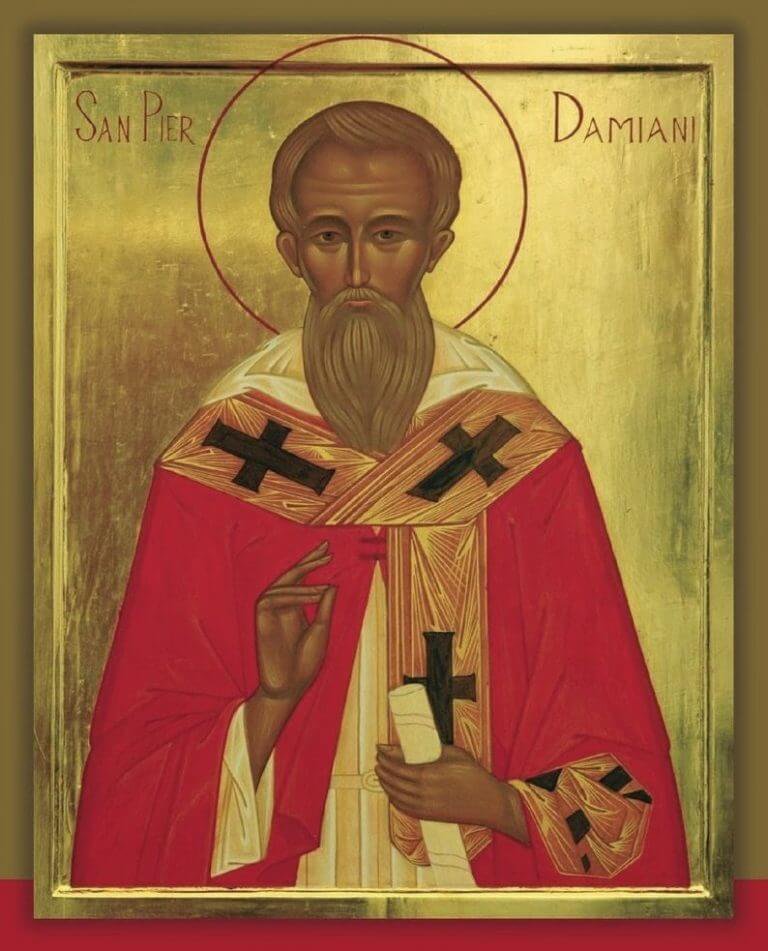 Saint Peter Damian
Saint Peter DamianSaint Peter Damian, Bishop and Doctor of the Church
1007–1072
February 21—Optional Memorial
Liturgical Color: White (Purple if Lenten Weekday)
Patron Saint of Faenza and Font-Avellano, Italy
A wise and holy monk becomes a Cardinal and thunders for reform in the Church
Every Catholic knows that the Pope is elected by, and from, the Cardinals of the Church gathered in the Sistine Chapel. Every Catholic knows that the Pope then goes to a large balcony perched high in the facade of St. Peter’s Basilica to greet the faithful and receive their acceptance. This is simply the way things are done in the Church. But it’s not the way things were always done. A Catholic in the early Middle Ages would have described a papal election as something like a bar room fight, a back-alley brawl, or a political horse race replete with bribes, connivings, and promises made just to be broken. Everyone—far-off emperors, the nobility of Rome, military generals, influential laity, priests—put their hands on the wheel to turn the rudder of the Church in one direction or another. Papal elections were sources of deep division, causing lasting damage to the Body of Christ. Then along came Saint Peter Damian to save the day.
Saint Peter headed a group of reform-minded Cardinals and others who decided in 1059 that only Cardinal Bishops could elect the Pope. No nobles. No crowds. No emperors. Saint Peter wrote that the Cardinal Bishops do the electing, the other clergy give their assent, and the people give their applause. This is exactly the program the Church has followed for almost a thousand years.
Today’s saint sought to reform himself first, and then to pull every weed that choked life from the healthy plants in the garden of the Church. After a difficult upbringing of poverty and neglect, Peter was saved from destitution by an older brother named Damian. Out of gratitude, he added his older brother’s name to his own. He was given an excellent education, in which his natural gifts became apparent, and then entered a strict monastery to live as a monk. Peter’s extreme mortifications, learning, wisdom, uninterrupted life of prayer, and desire to right the ship of the Church put him into contact with many other Church leaders who desired the same. Peter eventually was called to Rome and became a counselor to a succession of popes. Against his will, he was ordained a Bishop, made a Cardinal, and headed a diocese. He fought against simony (the purchasing of church offices), against clerical marriage, and for the reform of papal elections. He also thundered, in the strongest and clearest of language, against the scourge of homosexuality in the priesthood.
After being personally involved in various ecclesiastical battles for reform, he requested leave to return to his monastery. His request was repeatedly denied until finally the Holy Father let him return to a life of prayer and penance, where his primary distraction was carving wooden spoons. After fulfilling a few more sensitive missions to France and Italy, Peter Damian died of fever in 1072. Pope Benedict XVI has described him as “one of the most significant figures of the eleventh century…a lover of solitude and at the same time a fearless man of the Church, committed personally to the task of reform.” He died about one hundred years before Saint Francis of Assisi was born, yet some have referred to him as the Saint Francis of his age.
More than two hundred years after our saint’s death, Dante wrote his Divine Comedy. The author is guided through paradise and sees a golden ladder, lit by a sunbeam, stretching into the clouds above. Dante begins to climb and meets a soul radiating the pure love of God. Dante is in awe that the heavenly choirs have fallen silent to listen to this soul speak: “The mind is light here, on earth it is smoke. Consider, then, how it can do down there what it cannot do up here with heaven’s help.” God is unknowable even in heaven itself, so how much more unfathomable must He be on earth. Dante drinks in this wisdom and, transfixed, asks this soul its name. The soul then describes its prior earthly life: “In that cloister I became so steadfast in the service of our God that with food seasoned just with olive-juice lightheartedly I bore both heat and cold, content with thoughtful prayers of contemplation. I was, in that place, Peter Damian.” Dante is among refined company in the loftiest heights of heaven.
Saint Peter Damian, your reform of the Church began in your own monastery cell. You never asked of others what you did not demand first of yourself. You even endured the detraction and calumny of your peers. Help us to reform others by our example, learning, perseverance, mortifications, and prayers.
Taken from mycatholic.life. Visit this page for more great Catholic content
Catechism Corner
1 God, infinitely perfect and blessed in himself, in a plan of sheer goodness freely created man to make him share in his own blessed life. For this reason, at every time and in every place, God draws close to man. He calls man to seek him, to know him, to love him with all his strength. He calls together all men, scattered and divided by sin, into the unity of his family, the Church. To accomplish this, when the fullness of time had come, God sent his Son as Redeemer and Savior. In his Son and through him, he invites men to become, in the Holy Spirit, his adopted children and thus heirs of his blessed life.
In this first paragraph of the Catechism of the Catholic Church the Kerygma, or "Good News", is presented. God made us in His image and likeness to know and love Him. We sin, but God seeks us out and calls us to repent. Ultimately, God became man, specifically God the Son. Eternally begotten of the Father the Son was sent by the Father so we could know Him and be saved by Him. Through the Church we receive the graces Christ earned for us through the Holy Spirit. By becoming members of His Body, the Church, and disciples of Jesus, we are invited to share eternal life with Him in Heaven.
Saint of the Week - February 8
Saint Jerome Emiliani, Priest
1481–1537
February 8—Optional Memorial
Liturgical Color: White (Purple if Lenten Weekday)
Patron Saint of orphans and abandoned children
He was forever grateful after surviving an encounter with death
In the year 1202, a wealthy young Italian man joined the cavalry of his town’s militia. The inexperienced soldiers went into battle against a neighboring town’s larger force and were obliterated. Most of the retreating soldiers were run through with lances and left for dead in the mud. But at least one was spared. He was an aristocrat wearing fine clothes and new, expensive armor. He was worth taking hostage for ransom. The captive suffered in a dark, miserable prison for a full year before his father made the payment for his release. He returned to his hometown a changed man. That town was Assisi. That man was Francis.
Today’s saint, Jerome Emiliani, endured much the same. He was a soldier in the city state of Venice and was appointed the commander of a fortress. In a battle against a league of city states, the fortress fell and Jerome was imprisoned. A heavy chain was wrapped around his neck, hands, and feet, and fastened to a huge chunk of marble in an underground prison. He was forgotten, alone, and treated like an animal in the gloom of a dungeon. This was the pivot point. He repented of his godless life. He prayed. He dedicated himself to the Madonna. And then, somehow, he escaped, chains in hand, and fled to a nearby city. He walked through the doors of the local church and headed to the front to fulfill a fresh vow. He slowly approached a much venerated Virgin and placed his chains on the altar before her. He knelt, bowed his head, and prayed. His life was about to begin again.
Some pivot points can turn a life’s straight line into a right angle. Other lives change slowly, bending like an arc over a long span of years. The deprivations endured by Saint Francis of Assisi and Saint Jerome Emiliani occurred suddenly. These men were comfortable, had money, and were supported by family and friends. Then, shockingly, they were naked, alone, and chained. Saint Jerome could have despaired in his imprisonment. Many people do. He could have rejected God, understood his sufferings as a sign of God’s disfavor, become bitter, and given up. Instead, he persevered. His imprisonment was a purification. He gave his suffering purpose. Once free, he was like a man born anew, grateful that the heavy prison chains no longer weighed down his body to the floor.
Once he started sprinting away from that prison fortress, it was like Saint Jerome never stopped running. He studied, was ordained a priest, and travelled throughout Northern Italy founding orphanages, hospitals, and homes for abandoned children, fallen women, and outcasts of all kinds. Exercising his priestly ministry in a Europe newly split by Protestant heresies, Jerome also wrote perhaps the first question-and-answer catechism in order to inculcate Catholic doctrine in his charges. Like so many saints, he seemed to be everywhere at once, caring for everyone except himself. While tending to the sick, he became infected and died in 1537, a martyr to generosity. He was, naturally, the kind of man who attracted followers. They eventually formed into a religious Congregation and received ecclesiastical approbation in 1540. Saint Jerome was canonized in 1767 and named the Patron Saint of orphans and abandoned children in 1928.
His life hinged on one pivot. It is a lesson. Emotional, physical, or psychological suffering, when conquered or controlled, can be a prelude to intense gratitude and generosity. No one walks down the street more free than a former hostage. No one enjoys a warm, comfortable bed like someone who once slept on asphalt. No one gulps a breath of fresh morning air quite like someone who has just heard from the doctor that the cancer is gone. Saint Jerome never lost the wonder and gratitude that filled his heart at the moment of his liberation. All was new. All was young. The world was his. And he would place all his power and energy in God’s service because he was a survivor.
Saint Jerome Emiliani, you overcame confinement to live a fruitful life dedicated to God and man. Help all who are confined in any way—physically, financially, emotionally, spiritually, or psychologically—to overcome whatever binds them and to live a life without bitterness.
Taken from mycatholic.life. Visit this page for more great Catholic content
Saint of the Week - January 24
Saint Francis de Sales, Bishop and Doctor
1567–1622
January 24—Memorial
Liturgical Color: White
Patron Saint of writers and journalists
A gentleman of sterling character and many talents leaves a legacy
It is almost an act of rudeness to limit the life of today’s saint to one page. Saint Francis de Sales was a religious celebrity in his own day and age. He was an erudite, humble, tough, and zealous priest and bishop. He was holy and known to be holy by everyone, especially those closest to him. He mingled easily with princes, kings, and popes, who enjoyed his charming and educated company. He incessantly criss crossed his diocese on foot and horseback, destroying his own health, to visit the poor and humble faithful who were drawn to him as much as the high born. He embodied to the fullest that extraordinary pastoral and intellectual productivity, characteristic of the greatest saints, which makes one wonder if he ever rested a single minute, or slept a single night.
St. Francis de Sales was born and lived most of life in what is today southeast France. His father ensured that he received an excellent education from a young age, and his son excelled in every subject. His intellectual gifts, holiness, and engaging personality made him, almost inevitably, an ideal candidate for the priesthood and eventually the episcopacy. He was duly appointed the bishop of Geneva, a generation after John Calvin, a former future priest, had turned that deeply Catholic city into the Protestant Rome, leaving St. Francis as bishop of Geneva in little but name only.
In carrying out his ministry, St. Francis’ weapon of choice was the pen. His apologetic and spiritual works brought back tens of thousands of former Catholics to the faith after they had dabbled in Calvinism. Saint Francis’s works were so profound, original, and creative, and his love of God so straightforward and understandable, that he would be declared a doctor of the Church in 1877. In his most well-known book, Introduction to the Devout Life, he addressed himself to “people who live in towns, within families, or at court.” His sage spiritual advice encouraged the faithful to seek perfection in the mechanics shop, the soldier’s regiment, or on the wharf. God’s will was to be found everywhere, not just in monasteries and convents.
Many arduous pastoral trips through the mountains of his native region eventually wore him out. He never insisted on preferential treatment despite his status. He slept, ate, and traveled as a common man would. When he lay dying, mute after a terrible stroke, a nun asked him if he had any words of wisdom to impart. He asked for some paper and wrote three words on it: “Humility, Humility, Humility.” St. Francis is buried in a beautiful bronze sepulchre displaying his likeness in the Visitation Basilica and Convent in Annecy France.
St. Francis de Sales, we ask your intercession to aid us in leading a balanced life of study, prayer, virtue, and service. You were a model bishop who never expected special privilege. Help all those who teach the faith to convey our doctrine with the same force, clarity, and depth that you did.
Taken from mycatholic.life. Visit this page for more great Catholic content
Saint of the Week - January 17
St. Anthony, Abbot
(251–356)
January 17—Memorial
Liturgical Color: White
Patron Saint of butchers, skin diseases, gravediggers, and swine
A solitary monk trades the world for the desert sands, and so forges a new path
Many extraordinary people who live heroic, path breaking lives remain unknown to posterity for one simple reason—no one writes their biography. How many other saints, heroes, and martyrs would be known to mankind if just one witness to their actions had put pen to paper! Just one author is needed to introduce a great man to subsequent generations. Today’s saint may have been forgotten forever, and may have wanted to remain unknown. But a talented and famous contemporary of his wrote what he knew. Saint Athanasius, the great champion of orthodoxy at the Council of Nicea, wrote a short biography of his fellow Egyptian, The Life of Saint Anthony the Great. Saint Athanasius’ work was so widely shared, and so often translated, that it was never lost to history. It has preserved St. Anthony’s memory down to the present.
The first three centuries of the Church saw sporadic persecutions of Christianity which at times turned vicious. These spasms of violence against Christians produced a large class of martyrs, many of whose last words and sufferings were recorded in official Roman judicial documents or in the written testimonies of witnesses. As Christianity was legalized at the start of the fourth century martyrdom ceased to be the primary form of Christian witness. A new form of radical witness to Christ emerged—the witness of radical isolation, fasting, prayer, and penance of the desert fathers. These monks retreated into remote places to lead solitary lives of dedication to Christ. Foremost among these desert fathers was St. Anthony of the Desert, born around 250 A.D. He was not the first ascetic, but he was perhaps the first to take the radical decision to retreat into the desert.
St. Anthony had money and property as a young man. But upon hearing at Mass the words of Christ to the rich young man to “…go, sell what you have and give to the poor, and you will have treasures in heaven”, St. Anthony decided to seek not silver or bronze, but pure gold. He sold his goods, he removed himself from all temptation except those intrinsic to human nature, he battled the devil, he fasted, he prayed, and he even actively sought martyrdom. He became famous for being holy. Saint Anthony preceded St. Benedict by two hundred years. He offers us an example of being a monk outside of a community of monks in a monastery. He sought Christ alone in every sense. Alone in the desert, without family, community, or money. Alone to the world, he clinged to the only person who truly mattered—God himself. Saint Anthony’s path of holiness is both radical and refined. It is for few people to walk. But he was the first to walk it so well. He shows us that being alone, stripped of all worldly concerns, is a sort of rehearsal for death, where we will meet God alone, every last thread tying us to the world having been cut.
St. Anthony, we ask your intercession to help us cling to God alone. Help us to strip ourselves of those needs and concerns which stuff our lives from morning to night. Help us not to be distracted from the one thing, the only thing, the last thing, God Himself.
Taken from mycatholic.life. Visit this page for more great Catholic content
Gospel Commentary...
The Gospel from Friday, January 14th
Mark 2:1-12
When Jesus returned to Capernaum after some days,
it became known that he was at home.
Many gathered together so that there was no longer room for them,
not even around the door,
and he preached the word to them.
They came bringing to him a paralytic carried by four men.
Unable to get near Jesus because of the crowd,
they opened up the roof above him.
After they had broken through,
they let down the mat on which the paralytic was lying.
When Jesus saw their faith, he said to him,
“Child, your sins are forgiven.”
Now some of the scribes were sitting there asking themselves,
“Why does this man speak that way? He is blaspheming.
Who but God alone can forgive sins?”
Jesus immediately knew in his mind what
they were thinking to themselves,
so he said, “Why are you thinking such things in your hearts?
Which is easier, to say to the paralytic,
‘Your sins are forgiven,’
or to say, ‘Rise, pick up your mat and walk’?
But that you may know
that the Son of Man has authority to forgive sins on earth”
–he said to the paralytic,
“I say to you, rise, pick up your mat, and go home.”
He rose, picked up his mat at once,
and went away in the sight of everyone.
They were all astounded
and glorified God, saying, “We have never seen anything like this.”
Commentary:
In this account of the early part of Jesus' public ministry, we see that He has already become so popular that Our Lord can't escape from the crowds, even at His home.
Jesus chose this day to reveal His divinity, albeit in a slightly veiled way. First, Jesus forgives the man's sins. While this is something, which the scribes correctly point out, that only God can do, Jesus has only begun. Anyone can pretend to be God and just say, "your sin's are forgiven". However, what Jesus does next is not something one can pretend.
Jesus reads the minds of the scribes and tells them He knows what they are thinking. But what happens next is the proof that "astounded" them. Jesus essentially said, "I know only God can forgive sins, but you know what else only God can do? Heal a paralytic".
Jesus continued to reveal Who He is in His preaching and miracles. It was critical that those who followed Him believe in Him as God, so that they could accept all teachings and commandments, and accept His gift of eternal life.

